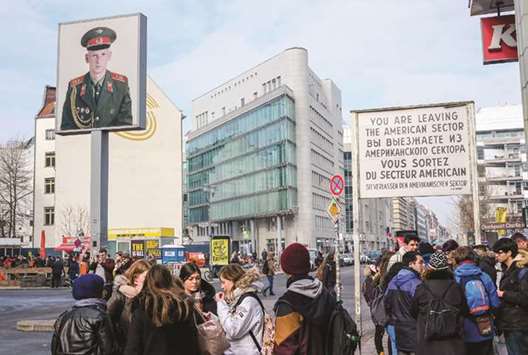more focused on catering to tourists than properly remembering the Cold
War and its effects on the country.

HIGH SEASON SPOT: Thousands of tourists come to Checkpoint Charlie daily during high season. However, many of them don’t get a sense of the border crossing’s importance with the area’s set-up.
Checkpoint Charlie, a symbol of German division, was the chilling scene of US and Soviet tanks facing each other when the Berlin Wall was built in 1961. Today, visitors barely understand the significance of the former border control point on Friedrichstrasse.
Yet 57 years after the wall was built and nearly 29 since its downfall, the place is a tourist magnet. In front of a reconstructed US Army control post, men dressed up as soldiers pose with US flags and charge 3 euros for a snapshot. A sign still warns ‘You are now leaving the American sector’ in several languages, but on closer inspection, it turns out to be a copy. The original can be found in the private Wall Museum a few metres away - and where a souvenir shop sells everything from Wall remnants to plastic models of the tiny East German car, the Trabi.
Next to a rotunda by the artist Yadegar Asisi with its panorama display illustrating a day in the once-divided Berlin, there is a stall serving up sausages and French fries, while a nearby street vendor is trying to sell gas masks and military caps.
Across the street, a ‘Black Box’ that had been set up by the Berlin Senate as an ‘antithesis to trivialisation’ does inform visitors about the Cold War. But near that is Charlie’s Beach, a spot that invites people to chill out.
“For 28 years, the place has lacked a clear design concept,” charges Axel Klausmeier, Director of the Berlin Wall Foundation. Berlin’s Senate bemoans the current state of affairs. “The way Checkpoint Charlie is used and experienced today, it is a place that attracts large numbers of visitors, but is highly divisive owing to its provisional design and mainly touristic use,” said Urban Development Senator Katrin Lompscher.
It seems “somewhat chaotic and partly overcommercialised,” she says. But improvement may be on the horizon: Politicians and a private investor who is keen to start construction on the site after several changes of ownership have finally agreed on the core of the design.
The extent of the border crossing point is likely to become clear in the future, and an ‘urban square with open spaces’ will be created. The plans also foresee setting up a museum in one of the new buildings as a ‘place of education and remembrance.’ While the opposition party talks about ‘obscure deals’ being made, Klausmeier hails the plans as a ‘great joint effort’ by the Berlin Senate and the investor. The opportunity to explain the historical dimension of the site adequately is thus within reach, he said.
Checkpoint Charlie was one of three control points of the Western powers in Berlin. There was checkpoint A in Helmstedt and checkpoint B in Drewitz. At the C - Charlie - checkpoint, only foreigners,diplomats and Allied military personnel could cross between East and West Berlin.
Today, tourists from around the world stand at the display boards or are led around by tour guides seeking to conjure up the era. Many visitors want to see ‘The Wall’ there and are disappointed, finding instead only the erstwhile boundary line embedded in the pavement. “The Wall was here? Wow, I wouldn’t have thought it,” says Amira, 26, a visitor from the US state of North Carolina. Lucy Gilcres, 32, from England, says, “It is an impressive place, but really touristy.” Indeed, it’s difficult to find evidence of the city’s division.
In the euphoria after the Wall was breeched in late 1989, huge sections of the monstrous concrete barrier, along with its watch towers and signal systems, were torn down, scrapped or sold. Property, some of it in the best downtown areas - were sold to private investors. Pondering the Wall’s meaning came only later on. “What is important is that with a museum at a historically important site, history will be made visible and explained,” said Culture Senator Klaus Lederer.
Klausmeier imagines Checkpoint Charlie in the future as a ‘networking place’ where visitors are informed about other sites of the city’s division. Berlin, he says, is “the largest contemporary history open-air museum in the world.”– DPA



